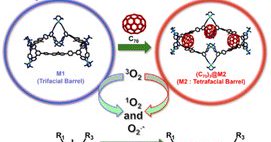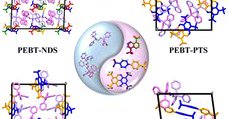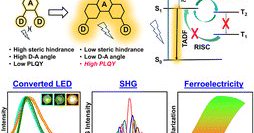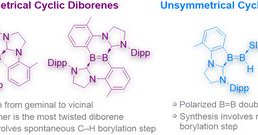
Chemical Science
@ChemicalScience
Followers
99K
Following
10K
Media
5K
Statuses
15K
This account has been archived. Stay connected with us on LinkedIn, BlueSky and Facebook.
Cambridge
Joined August 2009
🔥 New and HOT in Chemical Science! “Cu-mediated bipolar-type extended π-conjugated microporous polymers for lithium-ion battery cathodes with high energy density and fast-charging capability” by Wei Lyu and Yaozu Liao et al. Read it for free: https://t.co/dN8QzPQF8m
3
2
17
🔥 New and HOT in Chemical Science! “Enhancing binding affinity predictions through efficient sampling with a re-engineered BAR method: a test on GPCR targets” by Sangbae Lee and Art Cho et al. from Korea University, inCerebro, and Atomatrix Read it: https://t.co/y0zDC9McS6
0
3
21
Don't miss Silke Johannsen, Roland K. O. Sigel et al's recent article #ChemSciCovers 'Elucidating the solution structure of the monomolecular BCL2 RNA G-quadruplex: a new robust NMR assignment approach' 🔗 https://t.co/72rZiRPQBW
@sigel_lab @AliciaDguez1
0
3
20
📢 NEW #ChemSciCovers 'Evidence for I2 loss from the perovskite–gas interface upon light-induced halide segregation' by Hemamala I. Karunadasa et al. 🔗 https://t.co/AyFpbwVRAo
0
0
8
Don't miss Gayan B. Wijeratne, Brad S. Pierce, Hannah S. Shafaat et al's recent article #ChemSciCovers 'Modulation of heme peroxo nucleophilicities with axial ligands reveal key insights into the mechanistic landscape of nitric oxide synthase' 🔗 https://t.co/C7KHCb7Fr6
0
0
11
Issue 22 is here! Our front cover this week features Helen Tran et al 🤩 'Sequence-defined peptoids via iterative exponential growth' 🔗 https://t.co/wwJDGfgVAh
#ChemSciCovers
0
0
10
Happy to share our recent work in collaboration with @DA_catalysisLab @monojitroy80013 wherein we use a structurally transformed C70 complex to mimic alkene ozonolysis under red light irradiation @ChemicalScience. @Ranit96Banerjee @MedhaAggarwal4 @psm_lab
https://t.co/gSQ4WcnFYJ
pubs.rsc.org
Fabricating discrete molecular cages as fullerene receptors has been a compelling task. The main objective of confining fullerene molecules is to utilize their physico-chemical properties in commonly...
11
4
64
OPEN SINGLET DIRADICALOID as intermediate in the Ca-mediated reductive coupling of isocyanide finally resulting in a deltate complex. A unique mechanism in group 2 metal mediated reductive C-C coupling @ChemicalScience
https://t.co/FeZxgliWdz
1
20
108
🔥HOT🔥 research just published in Chemical Science! "Flexible phosphonium and sulfonate pair-to-pair self-assembled ionic organic single crystals for iodine capture" by Jia Chen, Hongdeng Qiu and co-workers (Chinese Academy of Sciences). Free to read:
pubs.rsc.org
In this work, four flexible chain phosphonium-based ionic organic single crystals (IOCs) are first facilely prepared by pair-to-pair ionic self-assembly of phosphonium salts and sulfonic acids...
0
2
14
This latest HOT article from Sangbae Lee, Art Cho and colleagues at inCerebro, Korea University and Atomatrix develops a new method for predicting the binding affinity of ligand-receptor complexes by re-engineering the BAR method. Read for free! https://t.co/tZP8f30ReP
0
0
4
"Reduced steric hindrance in a multicarbazole phenanthrene system facilitates low D–A angle, increased oscillator strength, enhanced TADF efficiency with NLO and Piezoelectric properties". Thanks collaborators Pankaj Mandal, Boomishankar. Chemical Science,
pubs.rsc.org
Multi-carbazole-based benzonitrile systems are efficient thermally activated delayed fluorescence (TADF) materials for organic light-emitting diodes (OLEDs). However, they suffer from low PLQY due to...
8
7
77
Corni's latest work on symmetrical and unsymmetrical cyclic diborenes is now published in @ChemicalScience! Many thanks to @kar_sourav, Andreas, @dario_duwe, and Rian! #chemtwitter #11B #UniWue
https://t.co/qNMvV13YVD
pubs.rsc.org
Cyclic diborenes are recognized for their diverse reactivity and properties arising partly due to their ring strain. However, progress in this field has been relatively slow due to the unavailability...
1
12
82
🚨 New paper alert! 🚨 Our latest study on #MOFs has just been accepted in @ChemicalScience! 🎉 👉 https://t.co/5xLZWc0qPy In collaboration with Omar Yaghi’s group at @UCBerkeley, we used molecular simulations 🖥️ to unravel how alkali metal ions (Li⁺, Na⁺, and K⁺) are taken
0
4
19
Published in @ChemicalScience: We used QM/MM MD & OPES simulations (pathCV) to study a multi-step chemical reaction catalyzed by a peptide ligand-protected metal nanocluster! Congrats, @tiwarivikas0 superb effort!👏 https://t.co/XWcxSMJYAe
@CCMB_IITD @Chemistry_iitd @iitdelhi
8
8
91
The method allows for direct observation of molecular motion differences attributed to polymer chain structures within real materials.
0
0
0
This allows tracking of the DCF in the DCF-Cu polymer on Cu (111) and exploration of the behaviour with increasing temperature - branched structures are found to be less mobile and linear structures and shorter polymers with free ends have greater mobility.
1
0
0
In this study the authors design 2,7-dicyano-9,9-dimethyl-9H-fluorene as a ligand for coordination polymers. The presence of the dimethyl group decreases the interaction with the metal surface and acts as an indicator of the ligand orientation.
1
0
0
🔥 New and HOT in Chemical Science! "Structural flexibility and mobility of coordination polymers on Cu(111)" by Waka Nakanishi, Masayuki Takeuchi and Keisuke Sagisaka from NIMS, Japan. Read it for free: https://t.co/kTWGNhAciy
1
1
4
@gilliardgroup @ccclabmit @RJGilliard Here, the authors use the elimination of hexamethylbenzene to construct transient sterically unhindered boron-containing unsaturated bonds.
0
0
1











